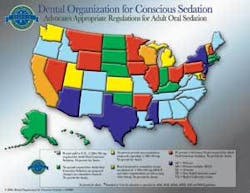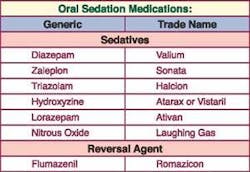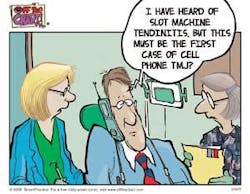Oral Sedation: What’s new?
LET’S CAST A HARSH LIGHT on what could be described as the underbelly of our dental care system: Right there, that massive throng of everyday people who desperately need dental care but vow to never ever step foot in a dental office.
We’ll turn the spotlight on a few of them - quickly, because of their unease. See her? She hasn’t smiled or fully revealed her mouth in public for more than a decade. That man over there has developed periodontal disease during the past 20-something years, which, if left untreated, will likely lead to dentures or possibly heart disease. And him? He’s too humiliated by his missing teeth to ever consider dating. He’s choosing loneliness over dental work.
null
null
Today the estimated size of this crowd ranges from nearly a third to as much as half of the general population.
These are fearful patients whose dread or outright phobia of anything dental stems from earlier traumas linked directly or indirectly to a dental experience. As children, many of them suffered pain or humiliation in the dental chair.Some were sexually assaulted nowhere near a dental office but now can’t bear to recline in a dentist’s chair. Whatever the reason, there’s just no way that any of them plans to become a patient of ours.
Not unless we, the dental community, make a socially conscious decision to reach out to this underserved - or more accurately, unserved - population. Many dentists - about 5 percent of us - already have successfully treated these patients safely with oral sedation dentistry. Many others are planning to do so, while still others are listening to the buzz surrounding the in-office treatment and waiting to see if a widespread trend takes hold. Meanwhile, fearful patients continue to suffer.
Fortunately, a growing number of these patients are gathering the nerve to respond to a dentist’s gentle invitation for care. It could be in the form of a radio ad they heard days, weeks, or even years before making an appointment. Dentists who’ve helped this segment say the patients are eternally grateful for the care they received, said Dr. Martha S. Cassity of Florence, Ky.
“Patients frequently tell us, ‘The sedation was great. I don’t remember anything after I sat down in the chair,’” Dr. Cassity said. “They also comment how fast the time went by. They find it difficult to believe that a four-hour appointment has passed in what seems to be minutes. Most tell us they didn’t feel anything and that it was a great experience. Having once had sedation, they won’t accept dental or periodontal treatment any other way. Many patients tell me that I have great drugs and that they will not consider having periodontal surgery without sedation.”
Whether or not you opt to offer this treatment, it’s wise to acquaint yourself with issues surrounding sedation dentistry, as well as the training needed to best treat patients and meet your state’s regulations.
But remember, the treatment isn’t only for fearful patients. Increasingly, busy patients find the treatment saves time by allowing them to undergo multiple and extensive procedures in a single, extended visit. It’s also useful for patients who can’t afford or who shun general anesthesia, or for those with pronounced gag reflexes.
“Sedation was a great benefit for my patients, and it made my job so much easier that I would have paid patients to be sedated,” Dr. Cassity said. “The training I received from the Dental Organization for Conscious Sedation helped me realize the value of my training. Through the two residencies I’ve completed - GPR and periodontics - I was trained and found to be competent in IV sedation. Nevertheless, I didn’t feel comfortable being responsible for monitoring patients’ depth of IV sedation while focusing on my surgery. Conscious sedation and adhering to the DOCS protocol allows me to keep my patients lightly, comfortably, and safely sedated. Normal protocol in our office is for patients to be monitored with a three-lead ECG, pulse oximeter, and blood pressure recording automatically every five minutes. My clinical staff is well-trained to monitor the sedated patients too.
“Sedation dentistry has breathed new life into my practice - a mental boost in the daily operations. I was becoming somewhat disillusioned with dentistry and it was affecting team spirit. I was tired of having patient behavior affect the outcome of my work. Now that behavior is controlled by having patients sedated, I look forward to coming to work and especially to the long procedures. I accomplish more work in these longer appointments and I produce my best work. My team members have also realized a renewed energy with their work. My team and I are confirmed practitioners of sedation dentistry. We offer our patients a greater service by keeping them more comfortable, producing the best surgical results, and confidently keeping them safe.”
What is oral sedation dentistry?
First, let’s address what it’s not: Oral sedation dentistry is not “sleep dentistry,” and it should never be referred to as such because patients are awake, feeling at ease, and able to interact throughout their treatment. Afterwards, they may feel as though they slept throughout the entire appointment because they have little or no memory of it.
“Anxiety-free dentistry” and “sedation dentistry” are more accurate descriptions depending on your state’s, province’s, or country’s regulatory requirements. Providing a comfortable and safe environment for patients is paramount, beginning with offering each patient a blanket just before treatment to provide added warmth and security.
There are two levels of oral sedation dentistry: light sedation, or anxiolysis, and moderate sedation, or conscious sedation. Conscious sedation can be administered by either single-dose or incremental-dose techniques. These levels are more similar than different because they involve the same patient assessment, airway management, monitoring, record-keeping, documentation and dismissal criteria. They differ in the depth of sedation. Single-dose and incremental-dose differ in that patients receiving incremental-dose sedation get additional medication at appropriate intervals during appointments that last from two to seven hours or more.
For light or single-dose sedation, patients are given oral medications prior to - not during - procedures that last anywhere from 90 minutes or less to about four hours. Anxiolysis is ideal for somewhat anxious patients who need a light level of sedation to help take off the edge. Ninety percent of your existing patients can be treated with anxiolysis.
The only other significant difference between these techniques pertains to your local regulatory requirements. Although dentists throughout the United States, Canada, and many other nations can perform anxiolysis without permits, some states and regions require dentists who perform conscious sedation (moderate sedation) to obtain oral sedation permits. Only a few regulatory bodies require training in intravenous sedation to obtain a permit to allow oral conscious sedation.
Although dental teams and regulatory bodies are aware of these differences, patients are not. What patients remember is a positive dental experience involving vague memories of the visit, accompanied by a feeling that they may have slept through the procedure. Best of all, they rarely experience any postoperative pain. This is one of the many mysterious benefits of providing dental care while a patient is totally relaxed and comfortable with oral sedation.
What’s needed
Patients undergoing oral sedation are able to respond to their dentists’ verbal commands and maintain normal respiratory and cardiovascular function throughout treatment.
To assess a patient’s sedation level, the dentist needs only to talk to him or her every few minutes during the procedure. The patient should respond and interact accordingly. Appropriate comments include, “You’re an excellent patient,” “How are you feeling?” and “Are you comfortable?”
To monitor a patient’s physical condition, you need a pulse oximeter to monitor pulse, oxygen saturation of the blood, and blood pressure. The oximeter should have a built-in printer, a stand for easy mobility, and comfortable blood-pressure cuffs. Other recommended equipment includes rubber dams, bite blocks, and cheek retractors; a chair pad without a headrest; a pill-crushing device; and a companion chair for dismissal.
Medications: Three oral medications commonly used for oral sedation come from the widely prescribed benzodiazepine family:
- diazepam;
- lorazepam; and
- triazolam.
These medications have sedative and hypnotic properties. As such, dentists are advised to provide patients positive feedback during the procedure, such as, “You’re doing great!” or “We’re way ahead of schedule.”
Among these medications, triazolam is considered the gold standard because it meets the criteria for an ideal oral sedative.
Some patients, however, shouldn’t take these agents, including but not limited to those who are pregnant, suffer from psychosis, have known hypersensitivities, have acute narrow angle glaucoma, and are on medications that have a severe interaction with the cytochrome iso-enzyme metabolic pathway (p450 CYP 3A4).
Besides these benzodiazepines, Zaleplon and hydroxyzine also may be given during oral sedation dentistry. Moreover, nitrous oxide can be used as an adjunct on an as-needed basis. Flumazenil is the reversal agent for the benzodiazepines and Zaleplon.
It’s imperative that dentists know what medications patients are taking and how they interact with medications used for oral sedation. DOCS strongly recommends that dentists use Lexi-Comp’s Dental Reference Library™ on CD-ROM to help evaluate interaction potential. For more information, logon to the DOCS Web site, www.SedationDOCS.com.
Administering drugs: Although the recommended medications used for both light and oral conscious sedation are the same, they differ in total dosage and administration.
Light or single-dose conscious sedation medications are administered in one of two ways:
➊They can be given twice before the procedure - once the night before the appointment to establish a blood level of the drug and help the patient rest comfortably, and then again one hour preoperatively; or
➋ A single dose may be given about one hour prior to the procedure.
Incremental-dose sedation patients who are highly or moderately fearful or who are undergoing lengthy procedures are given small doses of oral sedative at appropriate intervals to achieve and maintain a steady state of sedation. This allows dentists to better control the depth and length of sedation and maintain the lowest dose of a medication.
Specifically, these agents are administered one hour before the appointment, at the initial assessment, and then at subsequent assessments during the appointment - beginning 30 minutes to one hour after the initial assessment. Regulatory requirements on oral-sedation medications tend to change, so dentists should make sure they’re in compliance with current regulations. DOCS members receive this information as part of their membership benefits.
Protocols: Oral sedation protocols vary depending on the length of the procedure and type of patient being treated. There are numerous protocols for both light and moderate sedation that are based on length of treatment (number of hours). These protocols include recommended dosages for different types of patients, including those who are average, eldery, disabled, on CNS depressants, highly fearful, resistant to drugs, or weigh more than 200 pounds.
Dentists also need to consider several other factors before determining what protocol to use.These include assessing the level of a patient’s anxiety, intended sedation level, and invasiveness of the procedures being performed.
Many times, medications used for oral sedation are dispensed from an office, but they may also be prescribed in advance and picked up by patients at pharmacies.
Getting started
Are you ready to perform oral sedation dentistry? Perhaps, but you’ll be more competent with formal training. To prove this, see how well you can answer the following questions:
Patient assessment: Can you identify patients who would not make good candidates for oral sedation? Does your current medical-history form help you identify these patients? During incremental-dose treatment, do you know what to observe and ask patients to assess whether they need additional medication?
Physiology: How much do you know about basic human anatomy and physiology, and is it enough to safely administer medications for oral sedation? What is your knowledge of critical organ systems, including respiratory, cardiovascular, circulatory, gastrointestinal, central nervous, hepatic, and renal systems? What are major differences between adult and pediatric anatomy and physiology?
Pharmacology: How are drugs absorbed from the outside environment and distributed to their sites of action within the body? How are drugs metabolized within the body? How are drugs excreted? How do certain drugs interact with the body?
Emergencies: Are you well-versed in emergency protocol? For instance, what do you do if a patient experiences respiratory depression or an overdose reaction? What are the appropriate emergency procedures to follow if a patient experiences airway obstruction, chest pains, an allergic reaction, or hypoglycemia? Do you have adequate and up-to-date, in-office, emergency equipment?
Legal issues: How often should you take and document a patient’s vital signs? Specifically, what measures can you take to protect yourself legally? When did you last revise your informed-consent form? Do you know your local advertising laws? Should you inform your malpractice insurance carrier that you’re performing oral sedation dentistry?
Protocols: What should you tell patients before, during, and after procedures? What is the best protocol for dismissal? Do you know how to stimulate a patient during treatment so that he or she can be assisted to the bathroom? How do treatment plans differ for phobic patients?
Staying informed on evolving issues is important to your practice and patients. Dentists and their teams must learn to work as a united front in assisting and treating fearful and phobic patients.
Please join us in our effort to help dentists best treat patients with oral sedation dentistry. Let’s give fearful patients the means to calmly watch as we flick on and lower the dental light, shine a beam on them, and give them the lovely smiles they never thought they’d have.
Michael D. Silverman, DMD
Dr. Silverman is president and cofounder of the Dental Organization for Conscious Sedation. He practiced general dentistry for more than 20 years near Philadelphia, but now lives in Seattle and is a speaker on sedation dentistry. Reach him at [email protected], (877) 325-3627, or via www.DOCSeducation.com.
null








